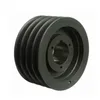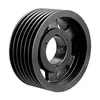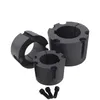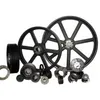A V belt pulley is a mechanical device used in power transmission systems. It features a grooved wheel that guides and drives a V-shaped belt, transferring rotational motion and power between shafts. These pulleys are essential in various industries, including automotive, manufacturing, and agriculture, due to their efficiency, reliability, and ability to handle high torque loads. The V-shaped design of the belt and pulley groove ensures a firm grip, reducing slippage and improving performance.
Our V belt pulleys are manufactured to meet high standards of quality and performance. Below are the detailed specifications in a table format for clarity.
| Parameter | Description | Range/Options |
|---|---|---|
| Material | The primary substance used for pulley construction. | Cast Iron, Steel, Aluminum, Polyurethane |
| Bore Size | Inner diameter for shaft mounting. | 0.5 inches to 6 inches (custom sizes available) |
| Outside Diameter (OD) | Overall diameter of the pulley. | 2 inches to 24 inches |
| Number of Grooves | Count of grooves for belt seating. | Single, Double, Multiple (up to 10 grooves) |
| Groove Type | Standard groove profile for belt compatibility. | A, B, C, D, E sections (per industry standards) |
| Hub Type | Design of the central hub for attachment. | Plain, Finished, Taper-Lock, QD (Quick Detachable) |
| Maximum RPM | Highest safe rotational speed. | Up to 10,000 RPM (varies by material and size) |
| Load Capacity | Maximum torque and power handling. | 5 HP to 500 HP (depending on configuration) |
| Weight | Approximate mass of the pulley. | 0.5 lbs to 150 lbs |
| Surface Finish | Coating or treatment for corrosion resistance. | Zinc Plated, Powder Coated, Anodized, Painted |
V belt pulleys are versatile components used in numerous applications. Common uses include:
What is the main function of a V belt pulley?
The primary function is to transmit power between rotating shafts using a V belt, providing efficient torque transfer with minimal slippage.
How do I choose the right V belt pulley for my application?
Consider factors such as shaft size (bore diameter), required speed ratio, power capacity, number of grooves, and environmental conditions (e.g., exposure to moisture or chemicals). Refer to the product parameters table above for guidance.
What materials are commonly used for V belt pulleys, and why?
Common materials include cast iron for durability and cost-effectiveness, steel for high strength, aluminum for lightweight applications, and polyurethane for corrosion resistance and quiet operation.
Can V belt pulleys be used in high-speed applications?
Yes, but it depends on the material and design. Steel and aluminum pulleys can handle higher RPMs, up to 10,000 or more, but always check the maximum RPM rating to ensure safety.
How often should V belt pulleys be maintained or replaced?
Inspect pulleys regularly for wear, cracks, or misalignment. Typically, they last for years under normal conditions, but replace them if you notice excessive noise, vibration, or belt slippage.
Are there different types of V belt grooves?
Yes, grooves are standardized into sections like A, B, C, D, and E, which correspond to belt sizes and power capacities. Ensure the pulley groove matches the belt type for optimal performance.
What is the difference between a fixed bore and a taper-lock pulley?
A fixed bore pulley has a set inner diameter and is mounted directly onto the shaft, while a taper-lock pulley uses a bushing system for easy installation and removal without damaging the shaft.
Can I customize a V belt pulley for specific needs?
Absolutely. We offer customizations in bore size, groove number, material, and finish to meet unique application requirements. Contact our support team for details.
How do I prevent V belt slippage?
Ensure proper tensioning of the belt, correct alignment of pulleys, and use of matched pulley and belt sizes. Regular maintenance checks can help avoid slippage issues.
What are the signs of a failing V belt pulley?
Common signs include unusual noises (squealing or grinding), visible wear on grooves, belt fraying, overheating, and decreased efficiency in power transmission.








